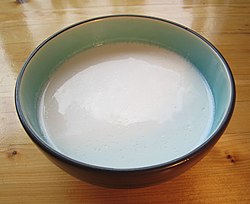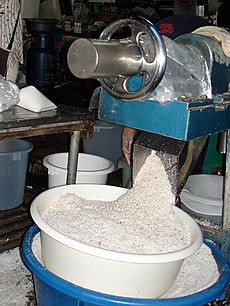ココナッツミルク
Coconut milk/ja
| ココナッツミルク | |
|---|---|
 | |
| 地域 | 伝統的に用いられる地域:東南アジア、オセアニア、南アジア、東アフリカ 導入された地域:カリブ海諸国、中央アメリカ、南アメリカ北部、西アフリカ |
| 主な材料 | ココナッツ |
ココナッツミルクは、成熟したココナッツのすりおろした果肉から抽出される植物性ミルクである。この乳白色の液体の不透明さと濃厚な味は、その高い油分に由来し、そのほとんどが飽和脂肪である。ココナッツミルクは、東南アジア、オセアニア、南アジア、東アフリカで伝統的に使用される食材である。また、植民地時代にココナッツが持ち込まれたカリブ海諸国、中央アメリカ、南アメリカ北部、西アフリカでも料理に使われている。
ココナッツミルクは脂肪含有量に基づいてサブタイプに区別される。これらは、最も脂肪分の多いココナッツクリーム(または濃いココナッツミルク)、最大約20%の脂肪分を含むココナッツミルク(または薄いココナッツミルク)、そしてごくわずかな脂肪分しか含まないココナッツスキムミルクに大別される。この用語は、欧米諸国で市販されているココナッツミルクでは必ずしも厳密に守られているわけではない。
ココナッツミルクは牛乳代替品(「ココナッツミルク飲料」と区別される)の製造にも使用できる。これらの製品は、飲料用ではなく料理用である通常のココナッツミルク製品とは異なる。プエルトリコ産の甘味を加えた加工ココナッツミルク製品は「クリーム・オブ・ココナッツ」としても知られる。これは多くのデザートやピニャ・コラーダのような飲料に使われるが、ココナッツクリームと混同すべきではない。
栄養
| Nutritional value per 100 g | |||||||||||||||||||||||||||||||||||||||||||||||||
|---|---|---|---|---|---|---|---|---|---|---|---|---|---|---|---|---|---|---|---|---|---|---|---|---|---|---|---|---|---|---|---|---|---|---|---|---|---|---|---|---|---|---|---|---|---|---|---|---|---|
| Energy | 962 kJ (230 kcal) | ||||||||||||||||||||||||||||||||||||||||||||||||
5.5 g | |||||||||||||||||||||||||||||||||||||||||||||||||
| Sugars | 3.3 g | ||||||||||||||||||||||||||||||||||||||||||||||||
| Dietary fibre | 2.2 g | ||||||||||||||||||||||||||||||||||||||||||||||||
23.8 g | |||||||||||||||||||||||||||||||||||||||||||||||||
| Saturated | 21.1 g | ||||||||||||||||||||||||||||||||||||||||||||||||
| Monounsaturated | 1.0 g | ||||||||||||||||||||||||||||||||||||||||||||||||
| Polyunsaturated | 0.26 g | ||||||||||||||||||||||||||||||||||||||||||||||||
2.3 g | |||||||||||||||||||||||||||||||||||||||||||||||||
| |||||||||||||||||||||||||||||||||||||||||||||||||
| Other constituents | Quantity | ||||||||||||||||||||||||||||||||||||||||||||||||
| Water | 67.6 g | ||||||||||||||||||||||||||||||||||||||||||||||||
| †Percentages estimated using US recommendations for adults, except for potassium, which is estimated based on expert recommendation from the National Academies. | |||||||||||||||||||||||||||||||||||||||||||||||||
100ミリリットル(ml)の摂取量において、ココナッツミルクは230キロカロリーを含み、68%が水分、24%が総脂肪、6%が炭水化物、2%がタンパク質である(表)。脂肪の構成には21グラムの飽和脂肪が含まれ、その半分はラウリン酸である(表)。
ココナッツミルクはマンガン(100gあたりDVの40%)の豊富な供給源(一日摂取量、DVの20%以上)であり、その他の微量栄養素は有意な含有量ではない(USDAの情報源の表を参照)。
定義と用語
ココナッツミルクは、乳化剤や増粘剤として機能するタンパク質を含む、比較的安定した水中油滴型エマルションである。不透明で乳白色をしており、水っぽいものからクリーミーなものまで様々な粘度がある。脂肪含有量に基づいて、ココナッツミルクは異なるサブタイプに分けられ、一般的に脂肪含有量の高い順に「ココナッツクリーム」、「ココナッツミルク」、そして「ココナッツスキムミルク」と簡略化される。ココナッツミルクとココナッツクリーム(それぞれ「薄いココナッツミルク」、「濃いココナッツミルク」とも呼ばれる)は、伝統的にココナッツが自生する国々では抽出段階に基づいて区別されている。 また、アジア太平洋ココナッツ共同体(APCC)や国連食糧農業機関(FAO)が設定した現代の基準でも区別されている。しかし、これらの基準は義務的ではないため、市販のココナッツミルク(特に欧米諸国)では常にこの用語が遵守されているわけではない。これが消費者の混乱を招く可能性がある。
アジア太平洋ココナッツ共同体は、ココナッツミルクとココナッツクリーム製品を以下のように標準化している:
| 製品 | 脂肪含有量 (%m/m) |
|---|---|
| 濃縮されたココナッツクリーム | 40–50 |
| 高脂肪ココナッツクリーム | 30–39 |
| 中脂肪ココナッツクリーム | 25–29 |
| 低脂肪ココナッツクリーム | 20–25 |
| 高脂肪ココナッツミルク | 15–20 |
| 中脂肪ココナッツミルク | 10–15 |
| 低脂肪ココナッツミルク | 5–10 |
| ココナッツスキムミルク | 0–1.5 |
コーデックス委員会は、ココナッツミルクとココナッツクリーム製品を以下のように標準化している:
| 製品 | 総固形物 (%m/m) min.–max. |
無脂肪固形物 (%m/m) min. |
脂肪 (%m/m) min. |
水分 (%m/m) max. |
pH |
|---|---|---|---|---|---|
| ライトココナッツミルク | 6.6–12.6 | 1.6 | 5 | 93.4 | 5.9 |
| ココナッツミルク | 12.7–25.3 | 2.7 | 10 | 87.3 | 5.9 |
| ココナッツクリーム | 25.4–37.3 | 5.4 | 20 | 74.6 | 5.9 |
| ココナッツクリーム濃縮物 | 37.4 min. | 8.4 | 29 | 62.6 | 5.9 |
ココナッツミルクはココナッツウォーターと混同されることもある。ココナッツウォーターはココナッツの種子内部に見られる透明な液体である一方、ココナッツミルクは成熟したココナッツの白い内側の果肉を手作業または機械的に圧搾して得られる抽出液である。ココナッツクリームは、細かく挽いたココナッツ果肉から作られる半固形のペーストであるクリームドココナッツや、甘味料を大量に加えたココナッツクリームから作られる加工品であるクリーム・オブ・ココナッツとも混同すべきではない。
伝統的な製法

ココナッツミルクは伝統的に、成熟したココナッツの白い内側の果肉をすりおろし、すりおろしたココナッツの果肉を少量の熱湯と混ぜて、果肉に含まれる脂肪を懸濁させることで作られる。すりおろし作業は手動でも機械でも行うことができる。ポリネシア人は、シーハイビスカス、ヘリコニア、またはココナッツ自体の繊維の特別な束を「タウアガ」と呼び、それを使って果肉からミルクを絞り出すことがある。

ココナッツミルクは伝統的に、ココナッツクリーム(または濃いココナッツミルク)と薄いココナッツミルクの2つの等級に分けられる。ココナッツクリームは脂肪分が約20%から50%である一方、薄いココナッツミルクは脂肪分が5%から20%である。 ココナッツクリームは、すりおろしたココナッツの果肉を直接ガーゼで絞った一番搾りから抽出される。少量の熱湯が加えられることもあるが、一般的にココナッツクリームは水が加えられずに抽出される。
重力分離を用いて、ココナッツクリームの最上層とココナッツスキムミルクの最下層を得ることもできる。これは、抽出した液体を1時間放置するだけで達成される。逆に、ココナッツクリームは水を加えるだけで、より薄いココナッツミルクに希釈することができる。

伝統的に調製されたココナッツミルクは、空気に触れると容易に腐敗するため、新鮮なうちに抽出された直後に利用される。室温28 to 30 °C (82 to 86 °F)で数時間放置すると、脂質の酸化とリパーゼ分解により酸敗する。酸敗したココナッツミルクは、強烈な不快な臭いを放ち、独特の石鹸のような味がする。

As coconut cream contains a higher amount of soluble, suspended solids, it works well as a good ingredient for desserts and rich and dry sauces. On the other hand, thin milk contains less amount of these soluble solids. Thus, it is mainly used in general cooking. The distinction between coconut cream and thin coconut milk is not usually made in western nations due to the fact that fresh coconut milk is uncommon in these countries and most consumers buy coconut milk in cartons or cans.
Coconut milk is also an intermediate step in the traditional wet process methods of producing virgin coconut oil by gradual heating, churning, or fermentation. These methods, however, are less efficient than coconut oil production from copra.
Coconut graters

Coconut graters (also called "coconut scrapers"), a necessary tool for traditionally extracting coconut milk, were part of the material culture of the Austronesian peoples. From Island Southeast Asia, it was carried along with the sea voyages of the Austronesian expansion both for colonization and trade, reaching as far as Polynesia in the east, and Madagascar and the Comoros in the west in prehistoric times. The technology also spread to non-Austronesian cultures in coastal East Africa by proximity. Manual coconut graters remain a standard kitchen equipment in households in the tropical Asia-Pacific and Eastern Africa, underscoring the importance of coconut milk and coconut oil extraction in the Indo-Pacific.
The basic design of coconut graters consists of a low bench or stool with a horizontal serrated disk (made of metal in Asia and Africa, and stone or shell in Oceania) attached on one end. A person sits on the bench and repeatedly scrapes the inner surface of halved coconut shells with both hands over the metal disk. The scrapings are gathered by a container placed below.
More modern mechanical coconut graters dating back to the mid-1800s consist of serrated blades with a hand crank. This version is believed to be a British invention.
Processed coconut milk products

Commercially processed coconut milk products use largely the same processes to extract coconut milk from pulp, though they use more mechanical equipment like deshelling machines, grinders and pulverizers, motorized coconut shredders, and coconut milk extractors.
They differ significantly in the bottling or canning process, however. Processed coconut milk products are first filtered through a 100 mesh filters. They are pasteurized indirectly by double boiling at around 70 °C (158 °F), carefully not exceeding 80 °C (176 °F), the temperature at which coconut milk starts to coagulate. After pasteurization, they are immediately transferred to filling vessels and sealed before being cooled down. They are then packed into bottles, cans, or pouches and blast frozen for storage and transport.
Manufacturers of canned coconut milk typically combine diluted and comminuted milk with the addition of water as a filler. Depending on the brand and age of the milk itself, a thicker, more paste-like consistency floats to the top of the can (a gravity separation, similar to traditional methods), and is sometimes separated and used in recipes that require coconut cream rather than coconut milk. Some brands sold in Western countries undergo homogenization and contain additional thickening agents and emulsifiers to prevent the milk from separating inside the can.
Due to factors like pasteurization and minimal contact with oxygen, processed coconut milk generally has a longer shelf life than traditionally prepared coconut milk. It is also more efficient than traditional methods at extracting the maximum amount of coconut milk from grated coconut.
Coconut milk powder
Coconut cream can be dehydrated into coconut milk powder which has a far longer shelf life. It is produced by adding maltodextrin and casein to coconut cream to improve fluidity and then spray drying the mixture. The powder is packaged in moisture-proof containers. To use, water is simply added to the coconut milk powder.
Coconut skim milk
Coconut skim milk is coconut milk with very low levels of fat (0% to 1.5%). It is a byproduct of coconut cream and coconut oil production and is usually discarded. However, it is increasingly being used as a food ingredient for products which require coconut flavoring without the fats (including coconut powder, coconut honey, and coconut jam). It can also be used as a base in the production of coconut milk beverages used as milk substitutes, as it does not contain the high levels of fat characteristic of regular coconut milk while still being a good source of soluble proteins.
Milk substitutes

Processed coconut milk can be used as a substitute for milk beverages, usually marketed as "coconut milk beverage". They are sometimes confusingly also simply labeled as "coconut milk", though they are not the same product as coconut milk used for cooking (which is not meant for drinking). Milk substitutes from coconut are basically coconut milk diluted with water or coconut skim milk with additives. They contain less fat and fewer calories than milk, but also less protein. They contain high amounts of potassium and are good sources of fiber and iron. They are also commonly fortified with vitamin D and calcium.
Filled milk
Coconut milk is also used widely for filled milk products. It is blended with milk (usually skim milk or powdered milk) for its vegetable oils and proteins which act as substitutes for expensive butterfat in some processed milk products. They include low-fat filled milk, evaporated reconstituted milk, and sweetened condensed milk.
Cheese and custard production
Coconut milk can also be used in cheese and custard production, substituting at most 50% of milk without lowering the overall quality of the products. By mixing skim milk with coconut milk, one procedure develops cheeses – including a garlic-spiced soft cheese called queso de ajo, a Gouda cheese substitute, and a Roquefort substitute called "Niyoblue" (a portmanteau of Tagalog: niyog, "coconut", and "blue").
豆乳の強化
ココナッツミルクは豆乳の脂肪分を強化するために使用でき、これによりその食感と味を本物の牛乳に近づけることができる。ココナッツクリームは、豆腐の製造時に豆乳に加えることで、嗜好性に影響を与えることなくカロリー密度を高めることも可能である。
クリーム・オブ・ココナッツ
クリーム・オブ・ココナッツは、コンデンスミルクに似た、とろみが強く、非常に甘い加工されたココナッツミルク製品である。元々はプエルトリコの企業ココ・ロペスによって製造され、アメリカ合衆国では特にピニャ・コラーダに用いられることで有名である。他のカクテルや様々なデザートにも使用できる。ココナッツクリームと混同したり、その代替品として使用したりすべきではない。
Cuisine
Coconut milk derivatives

In the Philippines, coconut milk can also be further processed into coconut caramel and coconut curds, both known as latík. The coconut caramel latík made from a reduction of muscovado sugar and coconut milk has been developed into a commercial product marketed as coconut syrup (not to be confused with coconut sugar derived from coconut sap).

A similar product found throughout Southeast Asia is coconut jam. It is known as matamís sa báo in the Philippines and uses only coconut milk and sugar. However, the coconut jam versions from Indonesia, Malaysia, and Singapore (kaya); Thailand (sangkhaya); Cambodia (sankiah); and Vietnam (banh gan), add eggs in addition to sugar. The latter versions are sometimes anglicized as "coconut custard" to distinguish them from the version without egg. Coconut jam and coconut custard have a thicker, jam-like consistency and are used as ingredients or fillings in various traditional desserts.
Food
Coconut milk can be used in both sweet and savory dishes. In many tropical and Asian cuisines, it is a traditional ingredient in curries and other dishes, including desserts.
Southeast Asia
In Indonesia, coconut milk is used in various recipes ranging from savoury dishes – such as rendang, soto, gulai, mie celor, sayur lodeh, gudeg, sambal goreng krechek, and opor ayam – to sweet desserts, such as serabi, es cendol and es doger. Soto is ubiquitous in Indonesia and considered one of Indonesia's national dishes. It is also used in coconut rice, a widespread Southeast Asian dish of rice cooked in coconut milk, including the nasi lemak of Malaysia and the nasi uduk of Indonesia.
In Malaysia, coconut milk is one of the essential ingredients in a lot of the dishes, this includes a few of the popular dishes in the region, such as the ubiquitous nasi lemak and nasi dagang, rendang, laksa, gulai and Tamil and Mamak style-curry, it is also used in dessert-making such as kuih lapis, kaya and dodol.
In the Philippines, diverse dishes cooked in coconut milk are called ginataán. They can range from savoury dishes to desserts. Coconut milk is widely used to make traditional Filipino kakanín (the generic term for rice pastries), including bibingka and biko, among others.

In Thailand, coconut milk is used in dishes such as tom kha kai, khao tom mat, mango sticky rice, and tom yum.
Latin America and the Caribbean
In Brazil, coconut milk is mostly used in northeastern cuisine, generally with seafood stews and desserts. In Venezuela, pulp dishes are prepared with coconut milk and shredded fish in a dish called mojito en coco. In Colombia and Panama, the grated flesh of coconut and coconut milk are used to make sweet titoté, a key ingredient in making arroz con coco (coconut rice).
Coconut milk is used to make traditional Venezuelan dishes, such as majarete (a typical Venezuelan dessert), and arroz con coco (the Venezuelan version of coconut rice).
Drink

In Southeast Asia, coconut milk is used to make many traditional drinks. Cendol is a popular iced drink from this region containing chilled coconut milk and green jellies made of rice flour. Coconut milk is also used in hot drinks such as bandrek and bajigur, two popular drinks from Indonesia. Sweetened coconut milk, and coconut milk diluted with water are two popular coconut beverages in southern China and Taiwan.
The jelly-like pulp from the inside of the coconut is often added to coconut water to make a tropical drink. In Brazil, for example, coconut milk is mixed with sugar and cachaça to make a cocktail called batida de côco. Puerto Rico is also popular for tropical drinks containing coconut, such as piña colada and coquito, which typically contain coconut milk or coconut cream.
飽和脂肪と健康リスク
ココナッツミルクの最も顕著な成分の一つはココナッツオイルであり、多くの保健機関がその飽和脂肪含有量の高さから、大量に摂取しないよう人々に勧告している。過剰なココナッツミルクの摂取は、高血中コレステロールの原因となる飽和脂肪であるラウリン酸の量により、コレステロールの血中濃度を上昇させる可能性もある。
園芸
1943年、ココナッツミルクが植物の成長を積極的に促進することが発見された。ココナッツミルクが植物の成長に寄与する要因は多数あるものの、主な原因はココナッツミルク中に存在するサイトカイニンの一種であるゼアチンの存在である。ココナッツミルク中のゼアチンは植物全般の成長を促進するが、ダイコンなどの特定の植物の成長は促進しない。しかし、小麦を栽培する培地に10%のココナッツミルクを加えると、著しい改善が認められている。
商業
ココナッツは熱帯気候で広く生産され、主に北米やヨーロッパ向けに缶詰製品として世界中に輸出されている。
関連項目
外部リンク
 Media related to Coconut milk/ja at Wikimedia Commons
Media related to Coconut milk/ja at Wikimedia Commons- "Making the Coconut Grater Stool" – George Town World Heritage Incorporated、マレーシア・ペナンによる動画
| この記事は、クリエイティブ・コモンズ・表示・継承ライセンス3.0のもとで公表されたウィキペディアの項目Coconut milk(30 April 2025, at 19:13編集記事参照)を翻訳して二次利用しています。 |
- Cold drinks
- Drink mixers
- Belizean cuisine
- Caribbean cuisine
- Coconut drinks
- East African cuisine
- Foods containing coconut
- Food ingredients
- Latin American cuisine
- Milk substitutes
- Non-alcoholic drinks
- Oceanian cuisine
- Plant milk
- South Asian cuisine
- Southeast Asian cuisine
- Vegan cuisine
- Vegetarianism and drinks
- West African cuisine
